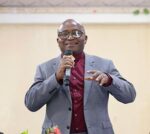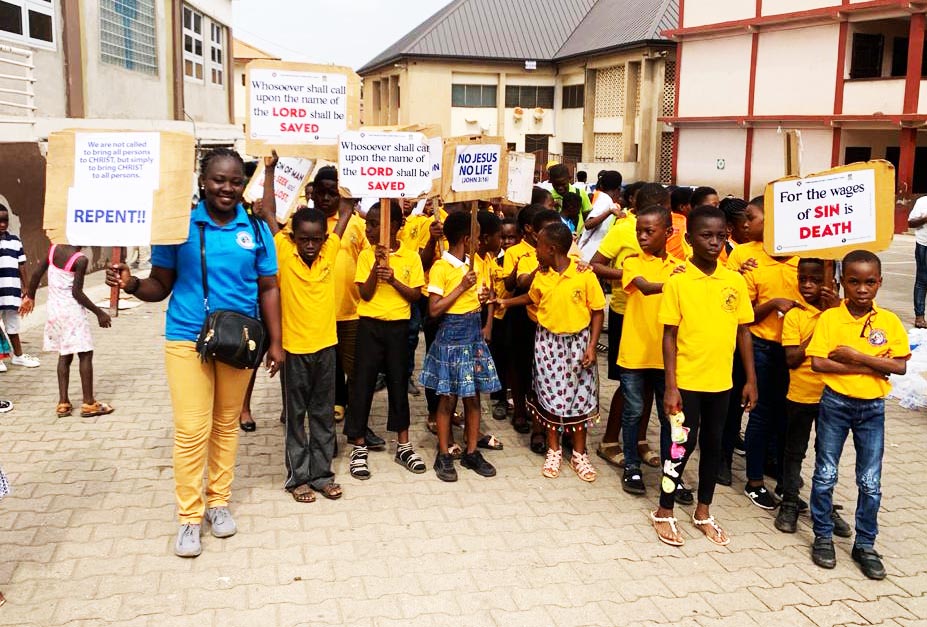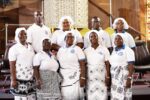From Synod To General Assembly-The Constitutional Journey of the Presbyterian Church of Ghana by A.A Beeko, Former Moderator of Synod PCG 1995-1999
In December 1917 the, the noble army of Bessel Missionaries was deported because of World War 1. Britain, the colonial power, was at war with Germany. Some of the missionaries were Germans, so it was felt unwise to have citizens of an enemy country in her territory. With the exit of the last Basel missionaries, a vacuum was created. Missionaries of the united free church of Scotland were formally invited by the colonial government to take the place of the Basel missionaries. The new set of missionaries led by the Rev. and Mrs. Willkie arrived in January, 1918.They were followed by Rev. J. Rankin, Mrs. Moffat, Miss G. M. Wallace and Miss I. P. Ross.
The Rev Dr. Arthur Willkie gave himself the task of organizing the church as a self-governing Presbyterian church. On 14th August, 1918, the synod of the whole church met at Akropong Akuapem. This comprised the new missionaries, twenty eight African ministers, and twenty four presbyters. The synod was constituted as the supreme court of the church. The Rev. Dr. Willkie made it clear that the Scottish mission was to continue the work of the Basel Mission without a change of method except as synod desired.
Decision
The first synod appointed an executive committee composed of eight African ministers and three missionaries.
The Rev. Peter Hall was appointed moderator, and the Rev. Nicolas T. Clerk, synod clerk.
There were eleven districts which were to be retained but some felt that changes were to be made in the near future. Synod took the decision to adhere to the existing form of church worship, as well as the establishment rules concerning church membership and discipline.
Funds were established for church. These were
- The central fund (church levy, anniversary collection and thank offering). This was to be used in the payment of all salaries and for the used in payment of all salaries and for the support of the senior schools and the seminaries.
- The congregation funds (Sunday and harvest offerings) to be used for local purposes.
- The synod fund (levied on each congregation according to its size) to be for local purposes. This, as its name implies, was to cove synod expenses.
Africans thus has full part of play in the administration of the church. Between 1918 and 1950, synods met every two years, thereafter, annually.
Presbyteries
At the time when the church attained independence in 1918, there were eleven pastoral districts in the whole country. Working with delight enthusiasm coupled with the strength and spirit of our living Lord, the noble band of missionaries and their Ghanaian fellow workers were able to plant more churches. As members multiplied, it was found expedient to organize the church into presbyteries. The decision was taken on 21st July 1922,at synod at Kyebi. The first presbyteries were:
- Ga and Adangme
- Akuapim and Anum
- Agona and Kotoku
- Akyem and Okwawu
- Asante and Asante Akyem
The constitution drafted by Dr. Willkie worked adequately for thirty years. With the passage of time and the development of the church, the constitution proved inadequate.
Departmental Committees
The administrative burden on the synod committee become excessive .Committee whose competence was carefully defined Synod minutes of 1950 shows that standing committees existed but had no executive power and could only remit suggestions to synod committees. With the establishment of Departmental Committees, the committees listed become Departments and could report directly to synod. These were:
- Finance
- Education
- Youth
- Literature
- Church Extension
- Women’s Word
Matters concerning land, property and worship were dealt with by the synod committee. An important fact was that the synod committee retained its position as the supreme executive of the church between synods.
THE POWERS AND FUNCTIONS OF SYNOD
These were clearly defined:
- The synod as representing the whole body of the church constitutes a bond of union, mutual confidence and love amongst all the congregations and Presbyteries.
- It is the organ for the expression of the judgment of the whole church, and in obedience to that will to lead the church into life and service.
As the church trusts in the guidance of the living spirit of God it is inexpedient to frame rules in such detail as might hinder the full and free development of an indigenous church.
- The Synod seeks through its meetings to discover the Will of God for the whole Church, and in obedience to that Will, to lead the Church into fuller life and service.
- The Synod has the oversight of all the activities of the Church. It deliberates on all matters which concern the whole Church in doctrine, in worship, in discipline and in government; and declares the mind of the Church and legislates thereupon.
- The Synod receives and disposes of petitions and appeals.
(Regulations, Practice and Procedure Revised Edition 1985 Par 94-99)
Life of Synod
Synod was not merely concerned about reports and administrative matters. The spiritual life of the Church engaged the attention of delegates. In 1920 for example, one whole afternoon was devoted to “How to Deepen the Spiritual Life of the Church”.
Leading the discussion, the Rev. A. W. Wilkie explained the importance of life, that it was the best gift from God and could only be maintained by living consciously with God. Jesus came to give abundant life. He did not live with the most strict and religious people, but with those who applied to him. The source of our life was the presence of God in us.
The minutes of Synod informs us that many ministers expressed themselves, and great stress was laid on the study and preaching of the Word of God with earnestness. Ministers and Catechists were exhorted to take Church calendars seriously, to keep to the periscopes but to deviate from them when necessary. Religious instructions in schools and Church were to be encouraged. The unwillingness of many teachers to give efficient religious instructions was discussed. Ministers were exhorted to examine schools in religious instructions quarterly, if possible, but certainly, twice a year.
It was emphasized that the use in the pulpit, of fables or stories intended to excite laughter was a great mistake and was to be checked. Greater attention was to be paid to the Bible and prayer meetings which should be tailored to suit local purposes, and made as interesting as possible by good preparation and brevity.
Families of agents and ministers were to give a good example by attending the services and meetings regularly. Regular Church attendance was to be encouraged.
It was a great joy for ministers and other delegates of Synod to meet. For one thing it was an occasion for agents to share experiences, hopes and fears. For another, it was a period of sober reflection on the work of the Church. The annual synod of the Church was therefore a highlight of the Church’s year, and also an inspiring occasion for all the pastors and presbyters who took part. The ministers normally held a retreat and conference the day before Synod.
On Synod Sunday, the Moderator set the pace for Synod by delivering the sermon, and unfolding the vision of the Church. In the evening, a solemn communion service was held. Each day of Synod began with a devotional service while the evenings were devoted to hearing special reports about Church Extension and Missions, Women’s and Youth Work.
On the first day of business, Synod was constituted by the Moderator. Thereafter the order of business was approved, the roll of delegates was presented and the commemoration of the faithful departed took place. These comprised deceased agents and presbyters. Newly ordained pastors, probationers, missionaries and specially invited visitors were presented. After the reading of greetings and the confirmation of previous Synod minutes, constitutional matters were dealt with. Committee reports were exhaustively discussed and approved together with a host of general matters submitted for endorsement by Synod. English was used but Synod delegates could speak local languages. At that time, these were only Twi and Ga. There were interpreters to do the necessary translations.
Naming the Church
The Christian Fellowship which had emerged as the fruit of the work of missionaries became a vibrant Church without a recognized name. Suggestions were given as the name of the Church. Some of these were “Mpanyimfo Asafo”, literally meaning “Elders” or “Presbyters’ Church”, and “Ga-Twi Church”. The Basel Missionaries returned in 1926. At Synod that year, at Abetifi, “The Presbyterian Church of the Gold Coast” was finally adopted after prayer. This decision marked an important step forward in the awareness of the Church’s autonomy and of its relationship to the two missionary bodies, namely, the Basel and the Scottish Missions. With the passage of time, the Church moved from self-government to complete independence. It is a fact that for some years the Scottish Mission held the right to veto any decision of a Church Court which was not considered to be in the best interest of the Church but this veto was never used. (Synod Minutes, 1918 par 9, Synod Minutes 1920 par 16). In 1929 the Regulations, Practice and Procedure, the RPP, was completely revised. This was indicative of the fact that while the Presbyterian Church of Gold Coast was in “historical continuity with the Basel Evangelical Mission Church”, it was then responsible for the ordering of its own life. In 1930 the Synod Committee became the legal trustees for all items of property of the Church. In the same year, at the Synod at Kumasi, the Church endorsed the continuing activity of the Basel and Scottish Missions within the Church as follows:
“The Synod gives thanks for the great work that has been done, and expresses the unanimous wish of the Presbyterian Church of the Gold Coast that the two societies carry on their work for us in love and unity” (Synod Minutes, 1930).
In 1950, the posts of General Manager of Schools and Treasurer were taken over by indigenes. By 1960, the term “missionary” was no longer in use. Our brothers and sisters from overseas were referred to as Fraternal workers”.
Improvement on the Court System
This brief survey shows that when the Synod was first instituted in 1918 the Courts of the Church were only two – Congregational Session and Synod. After all there were only eleven Pastoral Districts. It was in 1922 that Synod took the decision to carve the country into Presbyteries. It follows therefore that the courts of the Church became three from 1923 onward.
Even though there were developments like the creation of Departmental Committees and clear assignment of duties to Synod and certain committees, the courts continued to be three, namely, the Congregational Session, the Presbytery and Synod. The Revised Edition of the Regulations, Practice and Procedure (RPP) 1985, presents in detail provision for District Conferences, but there were no District courts.
The first hint about District Session was given in Synod Minutes 1987 par 36 (d):
“Introduction of District Sessions
This was recommended by the Moderator, the Rt. Rev. D. A. Koranteng, in his Moderatorial address. On the proposal of the Synod Clerk the recommendation was remitted to the Presbyteries”.
It was in 1988 that the decision on District Sessions was taken at Synod.
“District Session
The District Session idea which was mooted by the Moderator has been accepted by Synod for implementation in all Districts of the Church.” (Synod Minutes 1988 Page 42 Par 75 (d)
It becomes nakedly clear that it was during the tenure of office, and on the recommendation of the Rt. Rev. D. A. Koranteng, that the development of the Constitution of our Church was able to attain the maturity of using four courts which Churches having the Presbyterian form of government operate. This means since 1989, the Presbyterian Church of Ghana has had the Congregational Session, the District Session, the Presbytery, and Synod.
The Constitutional journey which started at the instance of Dr. Wilkie appeared to be at the summit, but not yet. It is certainly true that in Presbyterianism the courts are four, but the highest one is the General Assembly, and not Synod. What then prevents us from reorganizing our structures for Synod to attain the level of General Assembly? This was the question posed by many members of the Church. One of the most vociferous was the Rev. T. A. Osei of blessed memory.
Growing Numbers
At the inception of Synod, delegates to this gathering formed a small group of people. After all, there were only eleven pastoral districts. It was therefore very convenient for Synod to accommodate all ordained ministers and presbyters who turned up as delegates. With the expansion and growth in numbers, delegates attending Synod became a very unwieldy number and difficult to handle. It cannot be dismissed that all district ministers attending Synod did not bring some advantages to the Church. It was a great help. Communication was very bad. There were no telephone lines in most areas. People had to walk between towns and villages as transportation was a great problem. To be continued.





